Results 491 to 500 of 12091
Thread: Anandtech News
-
05-30-11, 04:21 AM #491
Anandtech: ASUS 2011 UX Series: Ultra Thin and Light Sandy Bridge
ASUS just unveiled its 2011 UX Series, which looks a lot like a MacBook Air:
p.p1 {margin: 0.0px 0.0px 0.0px 0.0px; font: 12.0px Helvetica} span.s1 {letter-spacing: 0.0px} The new UX comes with a 6Gbps SATA SSD, although ASUS didn’t reveal the manufacturer of the drive or the controller inside. The SSD enables what ASUS promises will be a 2 second wake time on the notebook, a trend that you’ll hear more about later this week.
{gallery 1090}
p.p1 {margin: 0.0px 0.0px 0.0px 0.0px; font: 12.0px Helvetica} span.s1 {letter-spacing: 0.0px} With the lid shut the new UX will last for up to 7 days in hibernation.
More...
-
05-30-11, 05:40 AM #492
Anandtech: ASUS ET2700: Taking A Crack At the 27" iMac
Rounding out Asus’s Computex 2011 day one announcements is the ET2700, the company’s first 27 inch all-in-one PC.
The prototype had previously been on display at CeBIT, but it’s getting its final announcement at Computex. The formal press release isn’t out yet so we don’t have the full specs, but Asus has published their photos of the PC. We do know it’s advertised to have a 178 degree viewing angle, so expect an IPS panel similar to the 27” iMac.
However its defining feature will be the fact that the monitor is in fact a capacitive touchscreen, meaning the ET2700 is fully capable of utilizing Windows 7’s touch capabilities. Going with a touchscreen is a logical progression from what Apple has done with the iMac, but it’s also a bit risky since it evokes the well-known “gorilla arm” problem. So we’ll have to see what Asus has in mind to combat this.
We’ll have more information on this later today once Asus publishes the full specifications and the price.
{gallery 1088}
More...
-
05-30-11, 11:00 PM #493
Anandtech: Computex 2011: ECS X79 and Llano Motherboards
I’ve been running around the Computex show floor all morning and finally managed to build enough of a lead ahead of my meetings to sit down and write up some of what I’ve seen.
Ian is going to be meeting with most of the motherboard makers at the show but I just stopped by ECS’ booth and got a look at its lineup of three Socket-FM1 Llano (A-series APU) motherboards and a Socket-2011 Intel X79 motherboard for use with Sandy Bridge-E due out later this year.
SNB-E has four 64-bit DDR3 memory channels which makes routing a pain. Motherboard manufacturers are dealing with the incredible number of traces by splitting the channels up and routing half of them on one side of the CPU and the other half on the other. LGA-1366 boards by comparison had all six channels on a single side of the CPU.
ECS is going to be shipping both ATX and microATX Llano boards later this summer. As I mentioned earlier, Llano will first launch as a quad-core mobile solution with dual-core and desktop versions following later.
{gallery 1092}
More...
-
05-30-11, 11:10 PM #494
Anandtech: The Ultrabook: Meet the New Thin and Light Intel Notebook
It's too cliché to proclaim netbooks are dead. Perhaps the appropriate phrase is netbooks are no longer interesting to write about, but they do have a roadmap going forward.
For years we heard about convergence in the PC and consumer electronics space. Our TVs, set top boxes and video players were all supposed to get more intelligent. Last year we saw the first real fruits of those efforts with the introduction of Google TV and devices like the Boxee Box. Convergence has finally reached mainstream, but the process isn't over yet.
The smartphone revolution is the beginning of a much larger convergence. A melding of computing devices, convergence between the smartphone and tablet, or the tablet and notebook PC. As is typically the case of any convergence process, this one doesn't have a clear end nor does it have a clear roadmap. Along the way there will be many attempts and likely more failures than successes until we meet the handful of devices and strategies that really make sense.
The smartphone will become even more PC-like and the tablet will become even more notebook-like. But where does that leave PCs? They too must evolve and play their role in this process of convergence, after all it will be PC technologies that ultimately drive the convergence (from the example earlier, is it any surprise that both Google TV and Boxee Box feature very PC-like processors running Linux based OSes?).
How does the PC evolve? Part of it is a change in software. Traditional desktop OSes won't go away, but they must incorporate the advantages and innovations brought by the players in the smartphone/tablet markets. Apple is at the forefront of much of this revolution and the next version of Mac OS X already starts to look more like iOS with its app store, app launcher and iOS-like full screen modes. Microsoft is rumored to be preparing a very tablet friendly UI that will layer upon Windows 8, which itself will span everything from tablets (and smartphones?) to desktops.
As we've learned in the past, software enables hardware and hardware enables software. The PC's changing role in the future also requires some new thought about hardware design and what sort of decisions microprocessor manufacturers are going to make going forward. We've already seen hints of this from both AMD and Intel. The two companies no longer make discrete CPUs but rather complete SoCs, similar to what you'd find in a smartphone just on a much larger scale. Like I said before, the PC will adopt the learnings of the smartphone and tablet industries as it evolves.
Today Intel is announcing the first step in that evolution, an announcement that we actually first heard about from another company a year ago. Read on to learn about Intel's Ultrabook.
More...
-
05-31-11, 02:50 AM #495
Anandtech: New Intel Marketing Terms: Smart Connect & Rapid Start Technology
In our Ultrabook article from earlier this evening I mentioned that Intel would be enabling a new technology with Ultrabooks that allows your applications that require real time updates (e.g. email, twitter) to keep receiving data even when your PC is asleep. In its opening keynote at Computex, Intel shed some more light on the technology.
It's called Intel's Smart Connect Technology. Using a software layer it'll periodically wake up your machine while in a sleep state to check for updates for things like email, Twitter, Facebook, etc... My guess is the software will just reactivate the network connection at a not-short interval so those applications can get updates. The result will be a machine that seems like it's been connected and constantly receiving updates while it was asleep.
Smart Connect Technology will debut in some Ultrabooks shipping at the end of this year, but with Ivy Bridge the technology will move to a push model instead of a pull model - which should be better for battery life.
The next technology is called Rapid Start. Rapid Start is simply hibernate to NAND, which allows your notebook to resume from a zero-power hibernate state in 5 - 6 seconds.
Expect both technologies in Ultrabooks starting at the end of the year.
More...
-
05-31-11, 03:00 AM #496
Anandtech: Computex 2011: Zotac Z68 miniITX Motherboards
Zotac has two mini-ITX Z68 motherboards on display at Computex: the Zotac Z68-ITX WiFi A and B models (Z68ITX-A-E and Z68ITX-B-E). Both feature Intel’s Z68 chipset with all of the goodness that brings along with it (mainly SSD caching). The A model has a PCIe x16 slot for discrete graphics and uses standard DDR3 DIMMs. The B model features a GeForce GT 430 on-board and thus uses SO-DIMMs to save on space.
Both boards feature four SATA ports, WiFi and accept standard ATX power (4-pin 12V and 8-pin 12V connectors on the B and A models, respectively).
The A model has two HDMI outputs and one miniDP out, while the B model has two DVI, HDMI and one DP output thanks to the on-board GT 430.
{gallery 1093}
More...
-
05-31-11, 03:20 AM #497
Anandtech: Intel Integrates USB 3.0 and Thunderbolt into Ivy Bridge Platform
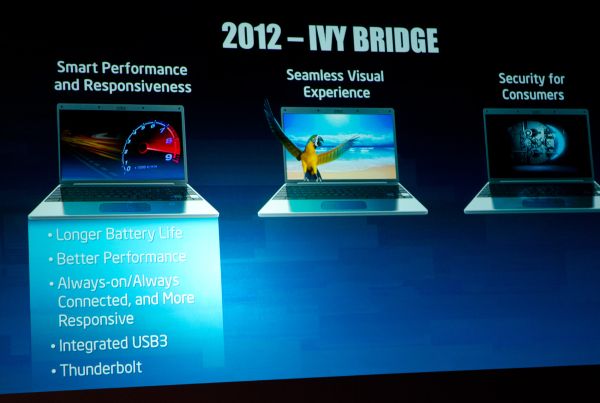
We knew about the first feature on this list (USB 3.0) would come with Ivy Bridge's 7-series chipset, but the second one was something I just heard about today. Ivy Bridge will integrate Thunderbolt into the chipset. Expect Thunderbolt adoption to skyrocket as a result in 2012.
More...
-
05-31-11, 03:20 AM #498
Anandtech: Computex 2011: Intel's Thin miniITX Sandy Bridge Platform
Intel's Mooly Eden just showed off its new thin mini ITX Sandy Bridge platform. The form factor is a standard mini ITX but with a low profile backplane so it can fit into thinner systems - particular all-in-ones.
Could this be the start of a DIY all-in-one market? I'm not sure about that, but it will help standardize components there and hopefully lower costs as you can reduce the number of custom components in the system.
{gallery 1095}
More...
-
05-31-11, 03:20 AM #499
Anandtech: Computex 2011: Intel Demonstrates Fanless 95W TDP Sandy Bridge All-in-One
That's right, what you're looking at is a 95W TDP Sandy Bridge All-in-One system that is cooled only via large heatsinks and no fan. Heat rises upwards and is vented out of the top of the machine but Intel says it doesn't need a fan. Apparently Intel holds some patents on the design and is willing to share it with its partners.
More...
-
05-31-11, 03:30 AM #500
Anandtech: Ivy Bridge: A Tick+ With Configurable TDP
With Turbo boost and power gating we took a step towards configurable CPUs. It didn't matter whether you needed one core or four, with power gating and turbo you got the best combination of active cores and clock speed. It has enabled platforms like quad-core notebooks that don't sacrifice performance in lightly threaded applications.
With Haswell Intel already committed to dropping notebook TDPs from 35 - 45W down to the 10 - 20W range. As a result you get thinner notebooks, but you do sacrifice peak performance. Intel doesn't want to make that tradeoff, so Ivy Bridge will be the first Intel CPU to introduce configurable TDP.
Ivy Bridge turbo won't just run up to the hard limits of your TDP, but it'll be able to exceed that TDP significantly (Intel wouldn't comment on the exact numbers) until the CPU gets too hot. You can imagine a 15W TDP part that could turbo up to 35W TDP for a matter of seconds to make your system feel ultra snappy without requiring a thicker notebook.
{gallery 1096}
The ultra configurable TDP will also have support for a docked mode. So if you take your Ivy Bridge notebook, stick it on a docking station with better cooling you'll be able to exceed the system's TDP consistently. Now your 15W TDP part works like a 35W TDP part because you've given it more cooling.
Configurable TDP will start with Ivy Bridge, but it'll be absolutely necessary (and likely much better) with Haswell. Look at what Turbo did from Nehalem to Lynnfield and I'm guessing we'll see the same sort of transition with Ivy Bridge to Haswell.
Ivy Bridge's configurable TDP will help OEMs build ultra thin notebooks without sacrificing performance - particularly when docked.
More...
Thread Information
Users Browsing this Thread
There are currently 14 users browsing this thread. (0 members and 14 guests)






 Quote
Quote
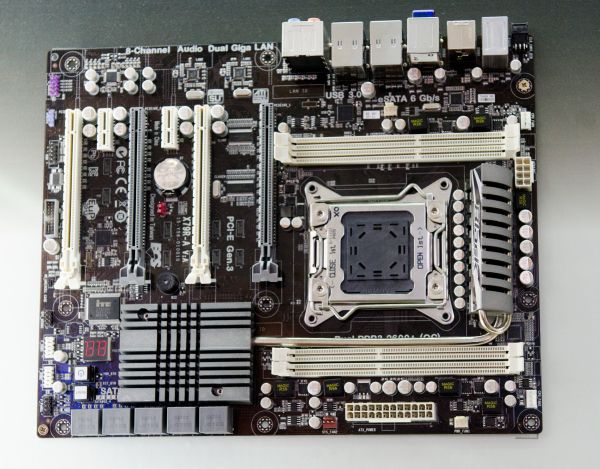
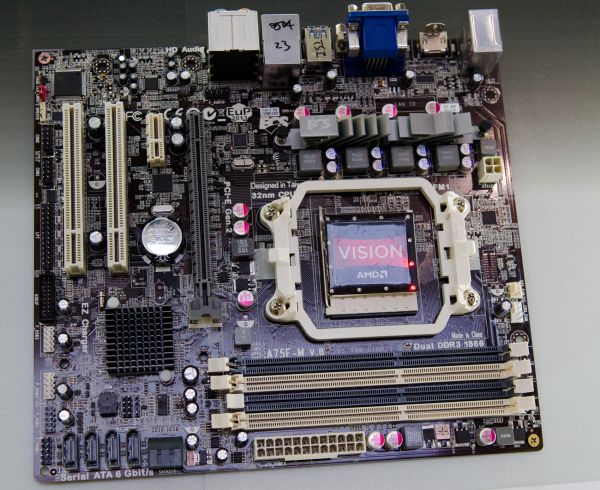
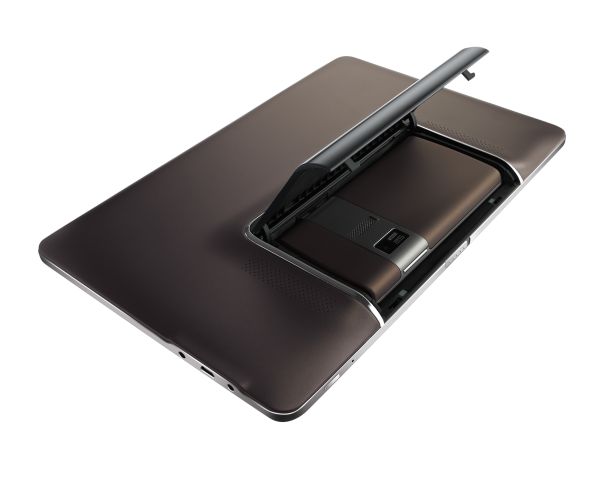

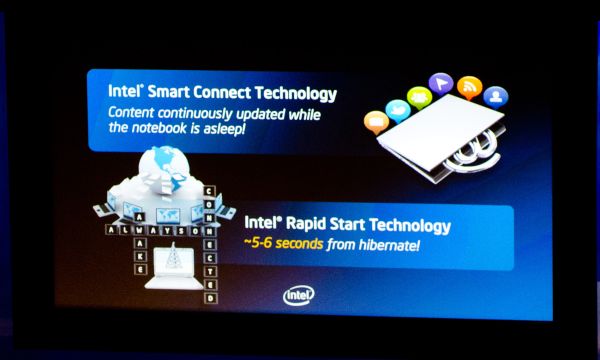



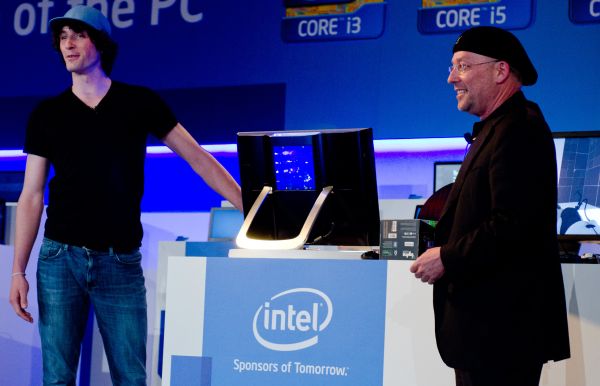
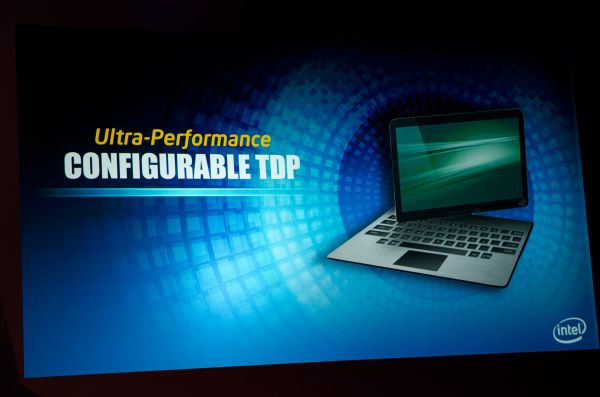
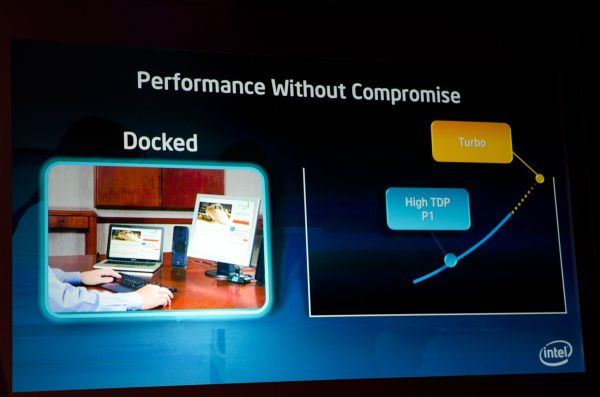
















Bookmarks